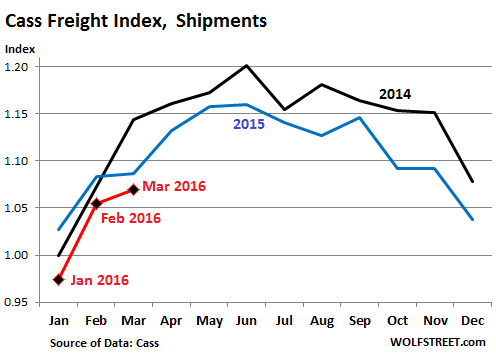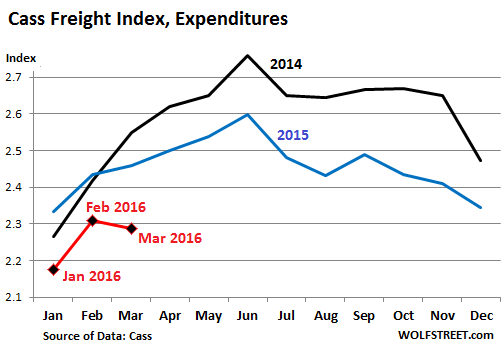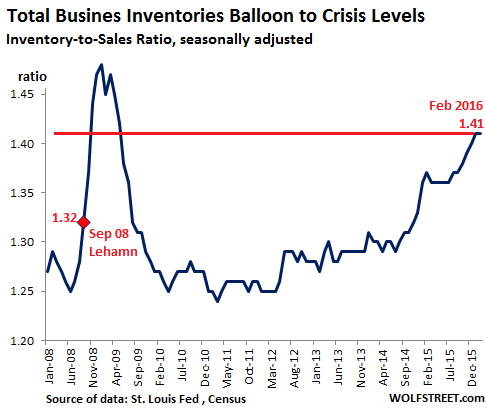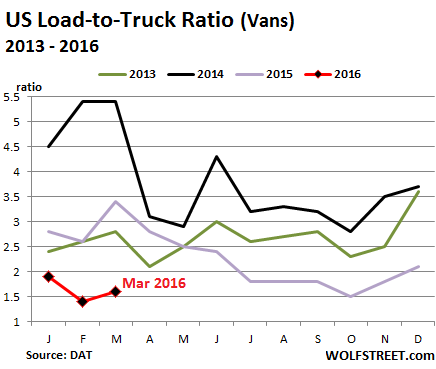Worst March, worst first quarter since 2010.
The goods-based economy in the US, largely dependent on the previously irrepressible but now strung-out American consumer, isn’t doing so well. To what extent things have deteriorated shows up in the freight data.
Freight shipments in March fell 1.5% in terms of volume from the already terribly low levels of March 2015, according to the Cass Freight Index. It has been an awful year so far. The index hit the lowest level for any March since 2010. This followed the worst February since 2011 and the worst January since 2010. This is not a blip.
On an average basis, volume in the first quarter fell 3.0% from the same period in 2015: the worst first quarter since 2010!
The Cass Freight Index tracks freight transactions by “hundreds of large shippers,” regardless of mode of transportation, including by truck and rail. It does not cover bulk commodities, such as oil and coal; so the mayhem taking place in those spaces is not reflected in the index. Instead, the index is focused on consumer packaged goods, food, automotive, chemical, OEM, heavy equipment, and retail.
The index is not seasonally adjusted. Hence the strong seasonal patterns in the chart. Note how out-of-whack 2016 (red line) has been so far:

To view the same issue from a dollar perspective: The Cass index for freight expenditures, which tracks the money spent on shipping products, plunged 7% in March from a year ago, on a combination of lower volumes and lower shipping rates. The worst March since 2011! On an average basis, it was the worst first quarter since 2011.
March is normally higher than February. That’s how it was every year going back to March 2009, when freight was still trying to find a bottom. But this year, it’s different. March was down 1.4% from February. After a really crummy 2015, this year is starting out much worse:

The report blamed part of the debacle on “high inventories,” which are “still a concern.” In fact, it’s the worst inventory glut since the peak of the Financial Crisis.
Total business sales in February, according to the Commerce Department last week, fell 1.4% on a seasonally adjusted basis from a year ago to $1.284 trillion, back where they’d first been in November 2012. But inventories rose 1.2% from the bloated levels a year ago, to $1.812 trillion. And the crucial inventory-to-sales ratio, which tracks how long inventory sits around in relationship to sales, has reached the level it spiked to in November 2008, just after the Lehman bankruptcy:

And these are the consequences of high inventory levels:
Inventories represent prior sales by suppliers. When companies try to reduce their inventories, they cut their orders. Suppliers see these orders as sales. As their sales slump, suppliers adjust by cutting their own orders, thus causing the sales slump to propagate up the supply chain [read… Why This Economy Is Now Running Aground].
Hence the quagmire the shipping industry is sinking into.
Within the industry, there’s a heated battle for market share between rail and trucking. Railroads, which are getting hammered by the collapse in oil and coal shipments, have been aggressively eating up market share. So far this year, the American Association of Railroads has been reporting strong growth in intermodal (container), the direct competitor to trucking.
At the same time, DAT has been reporting the other side of the story. The transportation data provider tracks national spot market demand for trucks and available capacity via its load-to-truck ratio – “a sensitive real-time indicator” of the balance between the two. And in the spot market, trucking has turned from bad to awful.
In March 2016 (red line), the load-to-truck ratio for van-type trailers plunged 53% from March 2015, and a dizzying 70% from March 2014:

The report by Cass, in its pro-and-con section on the economy, added a few more wrinkles: The manufacturing sector slashed 29,000 jobs in March; consumer spending has been “sluggish”; investment by businesses has been “weak”; and “global economic conditions are still weak and fragile in some economies, adding a level of uncertainty to the US economy.”
But then there’s hope, according to Cass: “Anecdotally, however, many players in the supply chain remain cautiously optimistic for the rest of the year.”
Which, ironically – this optimism despite reality for the past year and a half – is precisely why the inventory glut has reached such crisis proportion: a refusal to stare reality in the face, acknowledge what it is, and deal with it.
And now even financial engineering, the powerful force that has propped up stocks, is backfiring. Read… This Also Happened the Last 2 Times before Stocks Crashed
Enjoy reading WOLF STREET and want to support it? You can donate. I appreciate it immensely. Click on the mug to find out how:
![]()


Still waitin’ for the big k-boom…
When you see words like:
“…it’s the worst inventory glut since the peak of the Financial Crisis.”
…well, you should be a teeny bit terrified.
And when the piece finishes off with this:
“…this optimism despite reality for the past year and a half – is precisely why the inventory glut has reached such crisis proportion: a refusal to stare reality in the face, acknowledge what it is, and deal with it.”
Optimism?
There are ‘decision-makers’ out there who are optimistic?
THAT makes all of this so much worse. It means that level-headed and healthy decision making has flown out the door, and the eventual collapse will be magnified.
Hang on to your seats, kids. This is going to be bad.
John Little
Hi from Oz. More like a slow phfffft?
All bubbles pop suddenly and drop quickly. There is no exception. The debt bubble must go k-boom, but how and when?
How: Default of one country or a medium to large bank. Most likely it will be one of the unwatched pots which will blow-up, surprising everyone who is observing the developments.
When: nobody knows (except maybe some deep insiders with access to data. You can bet people who have access to some sensitive data are analyzing it for whatever anomalies they can find -not a conspiracy theory- it is simply the logical thing to do after 2008 left a lot of deer in the headlights). 2016 is a very good bet for “when” (as was 2015, btw)
Near zero interest rates means consumers must put aside more savings for retirement. Cheap money permits companies to buy back stock so as to increase their price per share. This mis-allocation of resources leads to inadequate investment into capital infrastructure that would lead to revenue generation and profits down the road. Exporting jobs to low wage countries means fewer middle class consumers able to ‘spend’ the economy back to health. Bailing out banks but forsaking the average American leads to distrust of government and a sense of disenfranchisement among the population. There is a sense of unease among rank and file Americans. Many people will keep what disposable income they have close and be prepared for the crash we all should know is coming.
The bartenders, landscapers, bottom wipers, and housekeepers are going to be spending this fall. Share prices “reflect” future expectations rather than past troubles. The labor market is expanding and soon these new workers will be getting pay raises from legislation or referendum. There’s plenty of room for credit expansion. You must trust your macro-prudential technicians. As Krugman would say, there is no point in bringing morality to technical problems.
Want to help the “people”?
Require all credit card companies to reduce all interest rates to 2%. Since these c.c. companies/banks get their “money” from the FED at 0.1%, they can do this.
Require all existing mortgages, held by banks or the Gov. agencies, to lower their interest rates to 2%, without any need of absurd paperwork.,
Require all “captive” car finance companies (those owned by the car companies that were bailed out the the people) to lower, automatically all car loans to 1%.
This will help the people/consumers, and pass on the “negative” % which so far has had no effect on the people’s expenses.
At least we can say it’s reassuring to learn the US is determined to keep civil lawsuits against terrorism from proceeding.
“High inventories” to blame?
And those too came about as a direct result of the ongoing counterfeiting of money and credit that is part of Keynesian “stimulus”.
It IS that simple.
The global Mr. Market and more to the point, Wall Street carry the “economy” on it’s back. That’s why the powers that should not be, will not allow Mr. Market to fall and do anything to prevent it from doing so.
So far it has worked, until it won’t. Then its game over. Match, set and game. Remember when the event occurs, it will be fast.
Mr. Market and along with it the economy, rise slowly, climbing a wall of worry like taking a slow escalator. However, on the way down it takes the express elevator, which more often than not ends up at the lowest level of the garage!
A report from the road. My anecdotal evidence coincides with the numbers. March was wretched and even staying out 30 days I fell just shy of 10,000 miles. Our trips reflect what is said of the life of savages i.e. ‘Nasty, brutish, and short’. The truckstops fill up quickly early in the day. I just ran a 201 mile trip where the lumpers probably made more than the trip paid the truck. It’s not pretty out here my friends.
Life is nasty, brutish and short is a quote from Thomas Hobbes’ book Leviathan, a book which vexed the English King so much he had to flee the country. It’s one of my all time favorites, I highly recommend it!
Thanks, Julian, for the update from the road!
“recession watch” ROL
How about “greatER DEPRESSION watch” – since 2008 vintage?
If freight volumes are so low, why am I getting 11,000 miles every month in my truck? Why am I typically booked out a week in advance for my loads? Why are all the truck stops and rest areas packed full early every night? Why are there so damned many trucks in my way everywhere I go?
I know it can turn on a dime, but…………
Compare your experiences to those of Julian the Apostate, above.
Interesting info from both of you, I’m seeing mixed results but we’re keeping busy. We do LTL reefer freight so never really a slow time, what type of freight are you guys hauling?
I know from our brokerage’s side the spot rates have softened quite a bit and you don’t have to search very hard in most lanes to find a truck. We use the same guys every week but anytime one takes a vacation instead of struggling all day to find one it’s a couple calls to the normal guys than 5 minutes on the board (weak market from the phone ringing off the hook test)
I’m leased to a small west coast curtain van carrier. Anywhere west of Denver,but primarily I-5 corridor. The Bay Area is still seeing plenty of construction, hence plenty of lumber coming south. The PNW
loves their alcohol so beer or wine northbound.
Almost all our freight is contract, we’ve even gotten some modest base rate increases to help with the disappearing FSC.
A month or two ago there was a weird lull and I had to take a couple of spot market loads. Very ugly! Like I said above, I know it can turn on a dime, but every month I’m one truck payment, one mortgage payment closer to being out of servitude.
No problem is have oodles of financial engineering trick to send the S&P to 2500 and beyond! Heck who needs an economy anyways.
Chinese investors dump U.S. stocks, but corporate buybacks offset losses
http://www.marketwatch.com/story/china-leads-trend-of-dwindling-foreign-interest-in-us-stocks-2016-04-18
Well,I am a truck driver with my own truck and freight volume suddenly stopped moving mid july of 2015 and it never recovered. Now days it’s “work harder,work cheaper” scenario and I predict by the end of this August,a lot of small companies will be going out of business,thanks to damn brokers who still charge good amount of money from customers and raised their mark up so they can keep up with the inflation. I hope uprising comes soon so money can be made from it. Honest work is a joke nowdays.